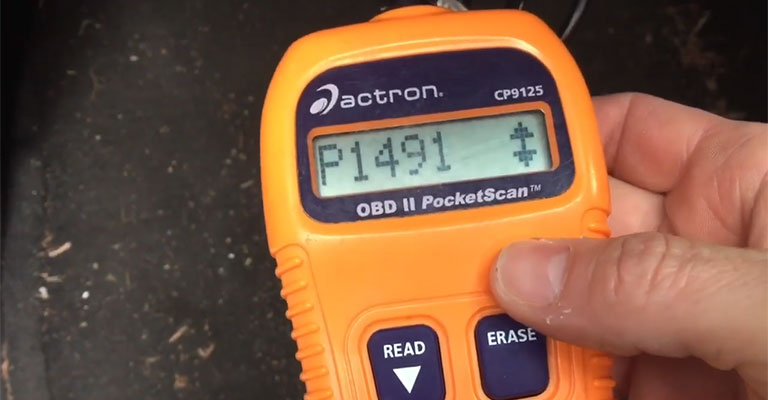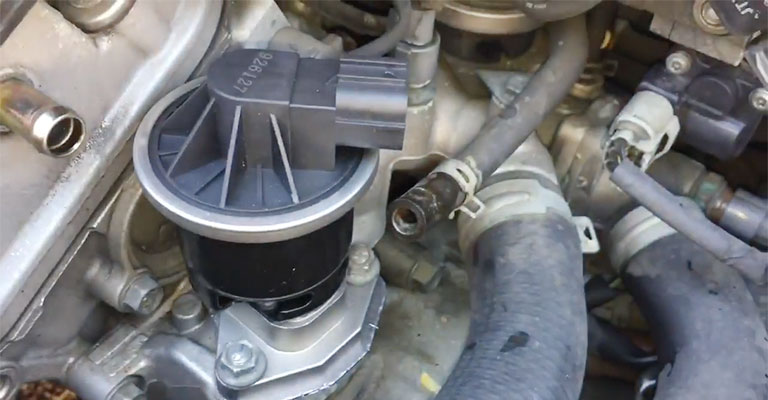A broken vacuum line connected to the EGR valve is the most common cause of DTC P1491 Honda codes. All vacuum lines should be checked to ensure that they are tight and not damaged.
A vacuum line never breaks in the open; it’s always under or behind something. So, you should remove them one by one, so you don’t get them mixed up, and thoroughly inspect them as well.
It is important to check the electronics that control the EGR system if the vacuum lines are good.

P1491 Honda Code Definition: Exhaust Gas Recirculation Valve Insufficient Lift Detected
Oxides of nitrogen (NOx) are reduced by Exhaust Gas Recirculation (EGR). However, when combustion temperatures are high, NOx is produced. Inactive exhaust gases are recirculated into the air/fuel mixture, thereby lowering peak combustion temperatures, and reducing NOx.
EGR valve position sensors detect the amount of valve lift and are integrated into the valve assembly. To optimize exhaust gas recirculation, the Powertrain Control Module (PCM) stores the command value for the target valve lift.
When the PCM compares the command value with the EGR valve position sensor value, it controls the valve to ensure it has the same lift as the command value.
An EGR valve or an EGR valve position sensor is considered faulty if the signals from the input EGR valve position sensor differ greatly from the command values in the PCM memory for a given period of time.
Honda DTC P1491 Causes Include:
- An error has occurred in the PCM
- There is a problem with the EGR control solenoid valve
- It is either open or shorted to ground in the EGR control solenoid circuit
- There is a problem with the lift sensor for the EGR valve. It is damaged or it has failed.
Symptoms Of P1491 Code:

The vehicle may seem to hesitate when misfiring occurs while the EGR valve is operating. It is possible to trigger the TCS warning indicator when such conditions are present.
Recheck to see if there are any other trouble codes throttle that does not respond intermittently and may be caused by an EGR or O2 sensor issue.
What Is The Troubleshooting Process For Code P1491?
To begin, check with your vehicle’s manufacturer to see if a technical service bulletin (TSB) is available. The manufacturer may have issued an update, or known fix, which will save you time and money.
If there are any other diagnostic fault codes, check them next. Prioritize diagnosing the most recent faults in the order in which they were stored.
- A misdiagnosis occurs when this code is diagnosed while another code is active, especially while this one is stored. Ensure that these codes are diagnosed before attempting to diagnose P1491 if they are present.
- Remember to take into account the notorious carbon deposits under the EGR valve, which extend into the intake manifold passages as well. Consider removing the EGR valve and cleaning the passages leading to the intake manifold if possible.
- The EGR Valve / Lift sensor / Position Sensor should be located if the P1491 is the only active fault code present and there are no updates/TSBs available for the vehicle.
- On the engine, the EGR valve is usually situated between the intake and exhaust manifolds. Check the wiring and connectors once they are located. Make sure there are no chafing, rubbing, bare wires, burn spots, or melted plastic.
- The terminals inside the connectors (the metal parts) should be inspected carefully after removing the connectors. Look for corroded, burned, or possibly green metal instead of the standard metal color you’re used to.
- The terminals can be cleaned with an electrical contact cleaner at any parts store, and the brush can be purchased at any hardware store. As soon as they’re dry, apply a light coat of dielectric grease to the areas where the terminals come into contact with one another.
- After clearing codes, test drives the vehicle for 15 – 20 minutes and see if the P1491 code returns. Again, it is most likely your connection that caused the problem if it doesn’t.
- EGR valves and their associated circuits will need to be tested if P1491 returns. At the EGR valve, there are usually five or six wires.
- Unplugging the EGR valve connector is the easiest way to fix this code. Check if code P1498 EGR Valve Position Sensor Circuit High is active after 30 seconds with the scan tool connected.
- It is a good indication that the wiring, the EGR valve/position sensor, and the PCM are working correctly. EGR valves and solenoids are most likely to be the problem.
- The sensor’s / solenoid’s associated circuits must be tested if the P1491 code remains active and the P1498 code does not set. During this stage, you may wish to seek the assistance of an experienced automotive diagnostician. To ensure proper installation, PCMs must be calibrated or programmed to match the vehicle.
What Is The Procedure For Clearing/Replacing EGR Valves?

Access the vehicle’s service manual for detailed information about tools and steps required. It is typically recommended that you use a 12 mm socket or a similar size.
The first thing you will need to do is remove the EGR valve. Afterward, you will need to clean the valve itself and the port it connects to.
Chemical cleaners of some sort are often necessary to remove carbon deposits. It is a standard practice to clean carburetors with carburetor cleaner. Clean, dry, and tighten the electrical connections as well.
Mistakes In Diagnostics
When diagnosing P1491 codes, technicians commonly make the following diagnostic mistakes:
- All wiring and connectors have not been thoroughly inspected.
- The EGR system is not being checked for blockages.
- Electrical circuits should be checked before replacing the EGR valve
- Failure to test all system components properly.
How Serious Is The P1491 Honda Code?
Repairing a P1491 code as soon as possible is recommended since it represents a moderate problem in terms of severity.
EGR valves can malfunction if they are not functioning properly, causing problems starting the engine and losing power at low speeds. Furthermore, it can lead to increased emissions and decreased fuel efficiency.
Final Words
A bad EGR valve, a faulty solenoid, or a faulty vacuum regulator can cause an insufficient lift in the EGR valve. Also, if there is a lot of carbon buildup in the intake manifold, you may want to remove it and clean the ports. Honda, Acura, and Isuzu typically use the code P1491 to identify their products.
An error code P1491 indicates that the PCM does not anticipate the EGR pintle position sensor’s correct range. There may be a problem with the sensor or with the valve itself. If the valve sticks or sticks open intermittently, the car will do several things.
First, it won’t run smoothly, stall frequently, and idle will not be good. Second, Acura, Honda, and Isuzu vehicles may display the P1491 diagnostic trouble code if their exhaust gas recirculation valves are faulty.
In this case, the PCM/ECM will set this code if it detects that the EGR valve is not opening far enough or at all. The most common cause of this code is a bad EGR valve, but it can also be caused by damaged wires or connectors, or by a blockage within the EGR valve itself.

Leave a Reply